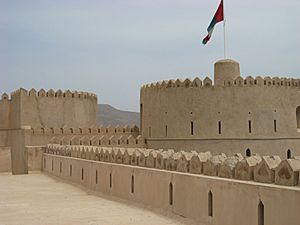Saif bin Sultan facts for kids
Quick facts for kids Saif bin Sultan |
|
|---|---|
| Imam of the Omani Empire | |
| Reign | 1692–1711 |
| Predecessor | Bil'arab bin Sultan |
| Successor | Sultan bin Saif II |
| Dynasty | Yaruba |
Saif bin Sultan (whose name in Arabic is Arabic: سيف بن سلطان) was an important leader, known as an Imam, from the Yaruba dynasty in Oman. He was part of the Ibadi branch of Islam. Saif bin Sultan ruled Oman from 1692 to 1711. During his time, Oman became very strong along the coast.
How Saif Became Imam
Saif bin Sultan was the son of Sultan bin Saif, who was the second Imam of the Yaruba dynasty. When his father passed away, Saif's brother, Bil'arab bin Sultan, became the Imam in 1679.
Later, Saif bin Sultan and his brother had a disagreement. Saif gathered his own army and surrounded Bil'arab in a place called Jabrin. After Bil'arab died there in 1692 or 1693, Saif bin Sultan became the new Imam.
Saif's Time as Imam
Saif bin Sultan worked hard to make Oman better. He invested in farming by building many aflaj (which are special water channels) in different parts of the country. These channels helped bring water to farms. He also planted many date palm trees in the Al Batinah Region. This encouraged people to move from inland areas and settle closer to the coast.
He also made sure new schools were built for the people. Saif bin Sultan chose the castle of Rustaq as his home. He even added a special wind tower called Burj al Riah to the castle.
Expanding Omani Power
Saif bin Sultan continued the fight against the Portuguese people who were in East Africa. In 1696, his forces attacked a city called Mombasa. They surrounded about 2,500 people who had taken shelter in Fort Jesus. This event, known as the Siege of Fort Jesus, lasted for 33 months. It finally ended when only thirteen people were left alive after facing hunger and sickness. They had to give up.
Soon after this victory, the Omanis took control of Pemba Island, Kilwa, and Zanzibar. Many Omani people then moved to Zanzibar to live there.
Saif bin Sultan appointed Arab governors to rule the cities along the coast. Later, some of these areas came under the control of Muhammed bin Uthman al-Mazrui, who was the governor of Mombasa. His family, the Mazrui, only pretended to be under Oman's rule. Saif bin Sultan also encouraged his people to attack merchant ships from India, Persia, and even Europe. This was a form of piracy.
Saif's Death and Legacy
Saif bin Sultan passed away on October 4, 1711. He was buried in a beautiful tomb inside the castle of Rustaq. However, this tomb was later destroyed by a general from the Wahhabi group.
When he died, Saif bin Sultan was very wealthy. It is said he owned 28 ships, 700 male slaves, and one-third of all the date trees in Oman. His son, Sultan bin Saif II, became the next Imam after him.
Saif bin Sultan was given the title "the Earth's bond" or "the chain of the Earth." This was because of all the good things he brought to the people of Oman.


